 |
|||||||||




 |
|||||||||





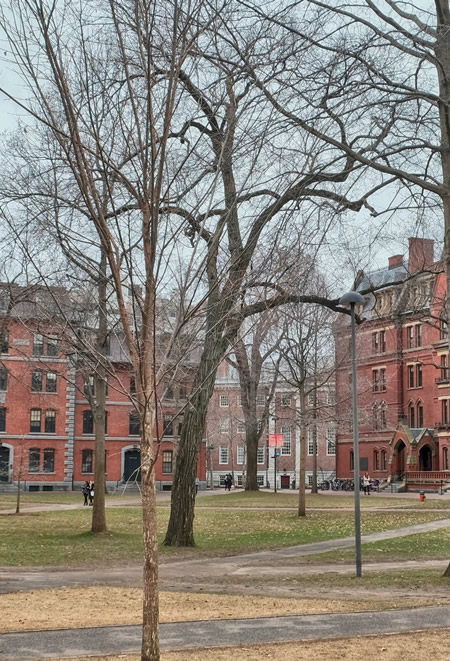
Photo: Harvard Yard, Harvard University, Cambridge, Massachusetts, USA. Image Credit: Jonathan E. Shaw.
London, June 6, 2018 — The fifteenth edition of the QS World University Rankings was released today by global higher education analysts QS Quacquarelli Symonds. QS ranks the world’s 1000 best universities, which come from 85 different countries.
KEY FACTS
QS evaluates the universities according to the following six metrics:
QS World University Rankings 2019: Top 20
Institution Name — Country/Territory
PERFORMANCE OF SOUTH ASIA (INDIA, PAKISTAN, BANGLADESH, SRI LANKA)
KEY FACTS
INDIA
QS RANK — UNIVERSITY
PAKISTAN
BANGLADESH
SRI LANKA
India’ positive performance is symptomatic of a successful year for the country’s higher education system, said Ben Sowter, QS Research Director.
“Indian progress can be primarily attributed to improvements in QS’s reputational indicators, which account for the insights of 83,000 academics and 42,000 employers. Seventeen of India’s 24 ranked universities improve their rank for Academic Reputation, while 13 improve their rank for Reputation among Employers,” Sowter added.
“Most of India’s other universities are struggling to improve their research impact, relative to global competitors. India’s universities are also struggling to internationalize in an increasingly competitive international education market,” Sowter explained.
R. Subrahmanyam, Secretary, Higher Education, HRD Ministry, expressed his view that the result of the QS World University Rankings 2019 is an affirmation of faith in the premier Indian higher educational institutions and an endorsement of the effectiveness of the measures being taken by Indian Government to improve the ranking of Indian institutions.
The Minister of Human Resource Development, Government of India, Mr. Prakash Javadekar said that the successes registered by Indian Institutions in QS World Best Universities Ranking 2019 released today is the result of relentless work in the premier institutions and various initiatives of HRD Ministry under the guidance and dynamic leadership of Prime Minister, Mr. Narendra Modi. The minister congratulated the Indian Institutes ranked among the top 500 institutions in the rankings.
|GlobalGiants.Com|
Kudos to the faculty & students of @iitbombay, @iitdelhi & @iiscbangalore for figuring in top 200 in the @worlduniranking #QSWUR #48MonthsOfTransformingindia #4yrsofmodigovt
— Prakash Javadekar (@PrakashJavdekar) June 7, 2018
Edited & Posted by the Editor | 3:15 AM | View the original post

Photo: Flowery trees, Balliol College. Balliol College, founded in 1263, is one of the constituent colleges of the University of Oxford, England, United Kingdom. Image credit: Piers Nye.
London, May 30, 2018 — The most valuable asset in a crowded market is reputation. Times Higher Education (THE) today announced the World Reputation Rankings 2018 comprising the world’s top 100 most prestigious universities.
According to Times Higher Education, its World Reputation Rankings are created using the world’s largest invitation-only academic opinion survey, a unique piece of research.
“The Academic Reputation Survey, available in 15 languages, uses United Nations data as a guide to ensure that the response coverage is as representative of world scholarship as possible. It is also evenly spread across academic disciplines,” THE elucidates.
The reputation table ranks institutions according to an overall measure of their esteem that combines data on their reputation for research and teaching.
World’s Top 100 Most Prestigious Universities in 2018
RANK — INSTITUTION — COUNTRY
51-60
61-70
71-80
81-90
91-100
The World Reputation Rankings are based on an invitation-only opinion survey of senior, published academics, who were asked to name no more than 15 universities that they believed were the best for research and teaching in their field.
From India, the Indian Institute of Science (IISc) Bengaluru has made it to the list in the 91-100 band. The last time it was featured was in 2011.
Commenting on IISc Bengaluru’s accomplishment, Phil Baty, editorial director of Global Rankings for THE, said, “Only 100 institutions in the world make it to this annual list of the most powerful university brands. So it is a highly significant achievement to be included. And it is fantastic to see an Indian presence this year.”
|GlobalGiants.Com|
Edited & Posted by the Editor | 2:55 PM | View the original post
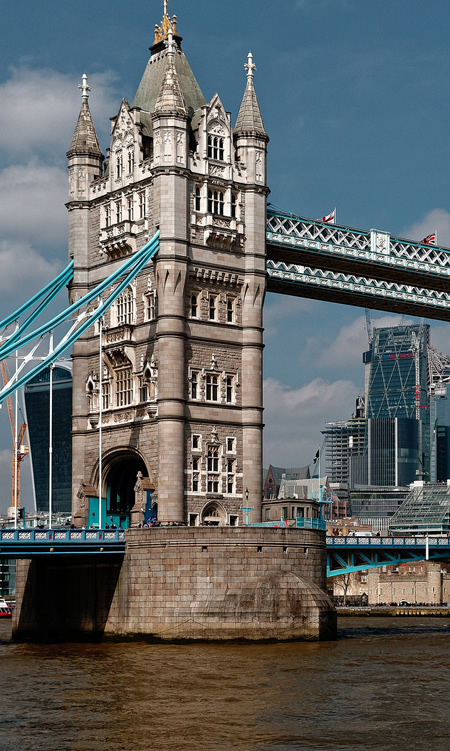
Photo: Tower Bridge, London. Image Credit: Tuomo Lindfors.
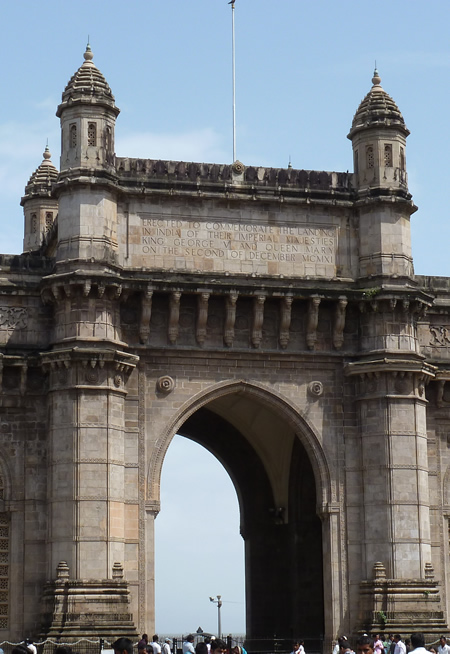
Photo: Gateway of India, Mumbai. Image Credit: Wessel Venter.

Photo: College Student. Image Credit: CollegeDegrees360.
LONDON, May 8, 2018: London is the world’s best student city. The fifth edition of the QS Best Student Cities Ranking, released today, sees London replace Canada’s Montreal as the world-leader.
London rises to the first position primarily as a result of increasingly positive responses to QS’s student survey, which asks students about the quality of experience in a city, and their willingness to remain there after graduating.
Ben Sowter, Research Director at QS, said: “The 2018 ranking highlights the enduring quality of the student experience available in London. The city benefits from outstanding employment prospects, more world-class universities than any other city, and excellent lifestyle opportunities. These factors mean that the capital remains a great place to study despite eye-watering costs - as more than 50,000 student respondents to QS’s survey have made clear.”
The QS Best Student Cities index, published annually, showcases the best urban destinations for international students. The index assesses cities for its University Rankings, Student Mix, Desirability, Employer Activity, Affordability, and Student View.
Key Observations:
Methodology
QS use six indicator groups to compile the ranking, each analyzing a different aspect of concern to prospective students.
QS BEST STUDENT CITIES 2018
RANK — CITY — COUNTRY
Mumbai (99th) represents India in the QS top 100 student cities for 2018. Located on the west coast at the site of a deep natural harbor, Mumbai, formerly known as Bombay, is India’s commercial, financial and entertainment capital. It is home to the Bollywood film industry and the highest number of millionaires in India.
|GlobalGiants.Com|
Ahead of Tokyo and Melbourne. Read more: https://t.co/FdFFyb1zYe pic.twitter.com/LSIBbCCpjm
— World Economic Forum (@wef) May 9, 2018
Edited & Posted by the Editor | 2:23 AM | View the original post
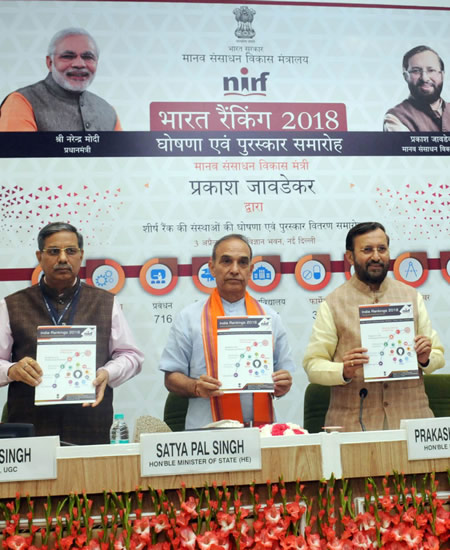
Photo: India Minister for Human Resource Development, Prakash Javadekar, releasing the India Rankings 2018 for Higher Educational Institutions at a function in New Delhi on April 03, 2018. The University Grants Commission Chairman and the Minister of State for Human Resource Development are also seen.
New Delhi, India. April 03, 2018. In a programme held in New Delhi today, India’s Human Resource Development Minister, Prakash Javadekar, released the National Institutional Ranking framework (NIRF) India Rankings 2018 in various categories on the basis of performance of Higher Educational Institutions.
Speaking on the occasion, Prakash Javadekar said that the idea behind these rankings is to promote quality in education and encourage competition to perform better and to set up new benchmarks of performance in Higher education space.
While Indian Institute of Science, Bengaluru bags 1st Position in Overall Ranking, IIT Chennai tops in Engineering, and IIM Ahmedabad tops in Management Category.
OVERALL RANKING
INSTITUTION — CITY — STATE
O Anusandhan Bhubaneswar Odisha Union Minister @PrakashJavdekar addressing at the release of India Rankings 2018 for Higher Educational Institutions & presentation of awards under National Institutional Ranking Framework #NIRF2018, #IndiaRankings2018 #TransformingIndia pic.twitter.com/KwpG8Y3DJB
— Ministry of HRD (@HRDMinistry) April 3, 2018
|GlobalGiants.Com|
Edited & Posted by the Editor | 12:26 PM | View the original post
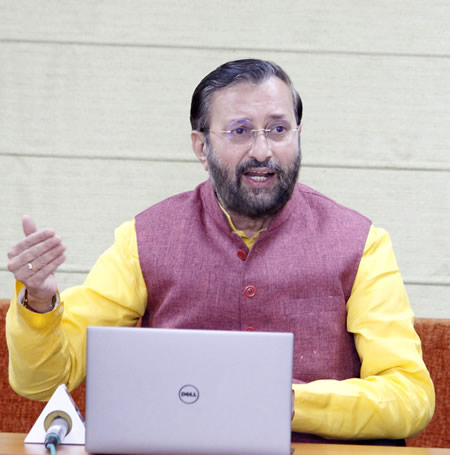
Photo: India’s Minister for Human Resource Development, Prakash Javadekar, briefing media on the decision of granting autonomous status to 60 higher educational institutions, in New Delhi on March 20, 2018.
The University Grants Commission (UGC) of India has granted autonomy to sixty Higher Educational Institutions. This was announced by the Minister of Human Resource Development, Prakash Javadekar, at a media briefing in New Delhi today. Javadekar said that the Government is striving to introduce a liberalized regime in the education sector and emphasis is on linking autonomy with quality.
Giving further details, Javadekar said that the sixty Higher Educational Institutions which have been granted autonomy include 52 Universities i.e. 5 central universities, 21 state universities, 24 deemed universities, and 2 private universities. Javadekar explained that these universities will remain within the ambit of UGC but will have the freedom to start new courses, off campus centers, skill development courses, research parks and any other new academic programs. They will also have the freedom to hire foreign faculty, enroll foreign students, give incentive based emoluments to the faculty, enter into academic collaborations and run open distance learning programmes.
Eight colleges have also been granted autonomy, the HRD Minister said. The eight autonomous collages will be free to set their own syllabus, hold examinations, carry out evaluation as well as declare results. In this case, only the degree will be awarded by the respective university.
Following is the list of universities granted graded autonomy:
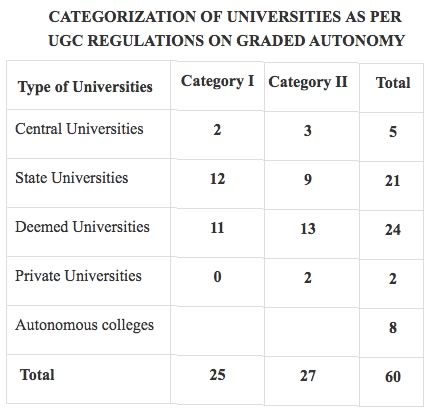
CENTRAL UNIVERSITIES
University — NAAC Score — Category
STATE UNIVERSITIES
University — NAAC Score — Category
|GlobalGiants.Com|
Edited & Posted by the Editor | 1:42 PM | View the original post
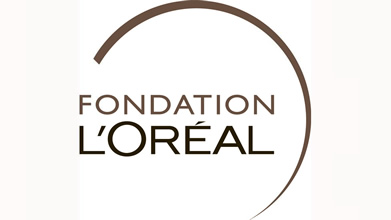

Photo: L’Oréal-UNESCO Laureate Prof. Thaisa Storchi Bergmann (by Brigitte Lacombe) on display at Orly Airport, Paris, France. Image provided by and copyright © L’Oréal Foundation / Stephane Cardinale / People Avenue.

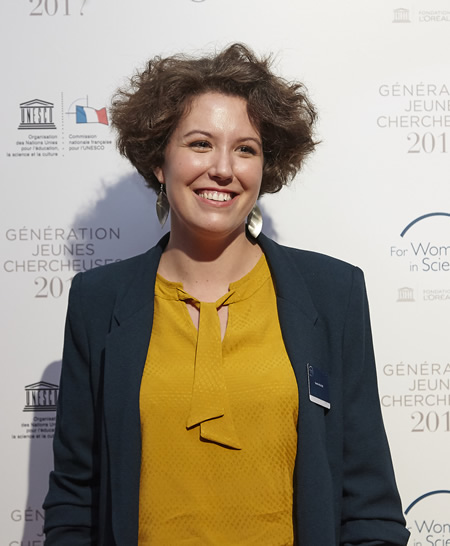
Photos: L’Oréal-UNESCO For Women in Science fellowships awardees. Images provided by and copyright © L’Oréal Corporate Foundation.

Photo: Dr. Weang Kee Ho, Malaysia. 2018 Young Female Talent. Image provided by and copyright © L’Oréal Corporate Foundation.
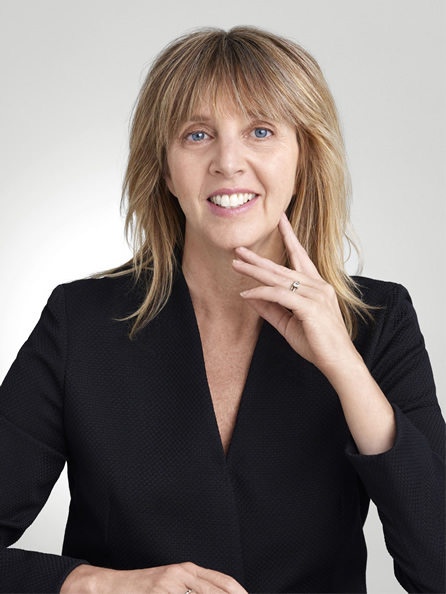
Photo: Professor Heather Zar. 2018 Women in Science Laureate. Professor and Chair, Department of Paediatrics & Child Health, Red Cross War Memorial Children’s Hospital. Director SAMRC Unit, University of Cape Town, South Africa. Image provided by and copyright © L’Oréal Foundation | Thierry Bouët.
UNESCO and the L’Oréal Foundation are preparing to honour five exceptional female scientists with the 2018 L’Oréal-UNESCO For Women in Science Awards at a ceremony on 22 March at UNESCO’s Headquarters in Paris.
The ceremony will follow a major scientific conference, organized by the L’Oréal Foundation and UNESCO on 21 March. These events will recognize leading women scientists and shine a spotlight on 15 talented young female scientists. They will also provide an opportunity to celebrate the 20th anniversary of the For Women in Science programme.
This year, UNESCO and the L’Oréal Foundation have recognized five exceptional female scientists.
Each of the five laureates will receive a prize of €100,000 and be honored for her contribution in the fields of medicine, palaeontology, molecular biology, ecology and developmental biology.
Over the last 20 years, the L’Oréal-UNESCO For Women in Science programme has raised the profile of 102 laureates and supported more than 3,000 young female scientists, helping them benefit from increased recognition within the scientific community. Three of these laureates have received science Nobel Prizes.
In order to further promote these women in science, the L’Oréal-UNESCO For Women in Science programme is raising public awareness of their achievements. It has launched an international communications campaign in seven international airports (Paris, New York, Beijing, London, Dubai, Sao Paulo and Johannesburg) and on the streets of Paris, in partnership with JCDecaux and Aéroports de Paris.
THE 2018 L’OREAL-UNESCO FOR WOMEN IN SCIENCE LAUREATES
AFRICA AND THE ARAB STATES
Professor Heather ZAR
Professor and Chair, Department of Paediatrics & Child Health, Red Cross War Memorial Children’s Hospital.
Director SAMRC Unit, University of Cape Town, South Africa.
ASIA-PACIFIC
Professor Mee-Mann CHANG
Professor, Institute of Vertebrate Palaeontology and Palaeoanthropology.
Member of Chinese Academy of Sciences, Beijing, China.
EUROPE
Professor Dame Caroline DEAN
Professor, John Innes Centre, Norwich Research Park, United Kingdom.
LATIN AMERICA
Professor Amy T. AUSTIN
Professor, IFEVA-CONICET, Facultad de AgronomÃa, Universidad de Buenos Aires, Argentina.
NORTH AMERICA
Professor Janet ROSSANT
Senior Scientist, The Hospital for Sick Children, Toronto, Canada.
University Professor, University of Toronto, Canada.
President, Gairdner Foundation, Canada.
THE 2018 L’OREAL-UNESCO FOR WOMEN IN SCIENCE INTERNATIONAL RISING TALENTS
Over the last 20 years, the L’Oréal Foundation and UNESCO have supported 3,022 talented young female scientists through research fellowships. These L’Oréal-UNESCO For Women in Science fellowships are awarded annually at national and regional ceremonies in 117 countries.
National and regional fellowships are awarded to 275 young women scientists each year. Out of these 275, the International Rising Talents programme targets the most promising 15 of these scientists.
The 15 young female talents honoured in 2018 are:
AFRICA AND THE ARAB STATES
ASIA-PACIFIC
EUROPE
LATIN AMERICA
NORTH AMERICA
|GlobalGiants.Com|
Edited & Posted by the Editor | 2:52 PM | View the original post

Photo: Indian Institute of Science Bangalore. The original building built in 1937. Image Credit: Bill.
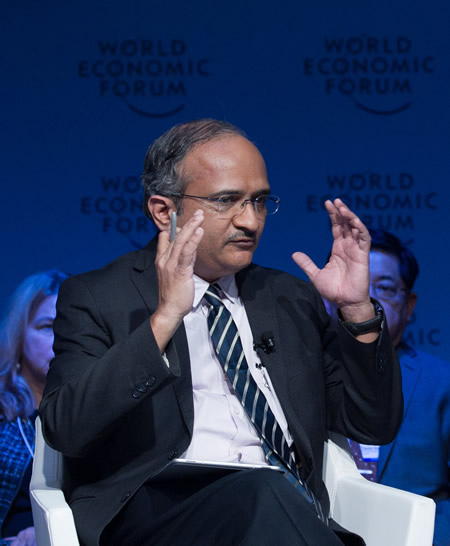
Photo: V. Ramgopal Rao, Director, Indian Institute of Technology, Delhi, India, speaking during the Session “Global Science Outlook” at the Annual Meeting 2018 of the World Economic Forum in Davos. January 23, 2018. Image provided by & copyright © World Economic Forum / Greg Beadle.
India’s University Grants Commission (UGC) has established the regulatory architecture to enable 10 public and 10 private institutions to emerge as World Class Teaching and Research Institutions named as ‘Institutions of Eminence’ (IoEs).
According to India government sources, an Empowered Expert Committee (EEC) has been constituted to select 10 Private and 10 Public Institutions of Eminence (IoEs) from the 114 applications which have been received by the Human Resource Development Ministry for the status of IoEs. No timeline has been prescribed in the Regulations for selection of IoE. The composition of the expert committee is as under:
The selected IoEs will have freedom to fix and charge fee from foreign students without restriction and would have the freedom to determine the domestic students fees, subject to the condition that no student who gains admission should be turned away for lack of finance.
The IoEs shall have flexibility of course structure in terms of credit hours and number of years to take a degree, after the approval of its Governing council and subject to broadly conforming the minimum prevailing standards.
The IoEs will have freedom to enter into academic collaboration with top 500 Global ranking institutions without approval of the Government or UGC except with institutions from negative list of countries determined by the Ministry of External Affairs or by the Ministry of Home Affairs.
Under Public Sector, 10 Central Universities, 25 State Universities, 6 Deemed to be Universities, 20 Institutions of National Importance and 6 Standalone Institutions have applied. Under Private Sector, 9 Private Universities and 16 Deemed to be Universities have applied.
Among those who have applied from the public sector are seven Indian Institutes of Technology (Madras, Delhi, Bombay, Kharagpur, Kanpur, Guwahati, Roorkee), Delhi University and Jawaharlal Nehru University, Jadhavpur University, Goa University and Mangalore University.
Indian Institute of Management Ahmedabad, Indian Institute of Management Calcutta, Indian Institute of Management Bangalore, and Indian Institute of Science Bangalore have also joined the race along with the Mumbai-based Tata Institute of Social Sciences and the Tata Institute of Fundamental Research.
The Central University of Hyderabad, Aligarh Muslim University, Banaras Hindu University, Madras University, Pondicherry University, and Mysore University have also applied.
From the private sector, the O P Jindal Global University, Ashoka University, Manipal University and Amity University, among others, have applied for the tag.
|GlobalGiants.Com|
Edited & Posted by the Editor | 7:27 AM | View the original post

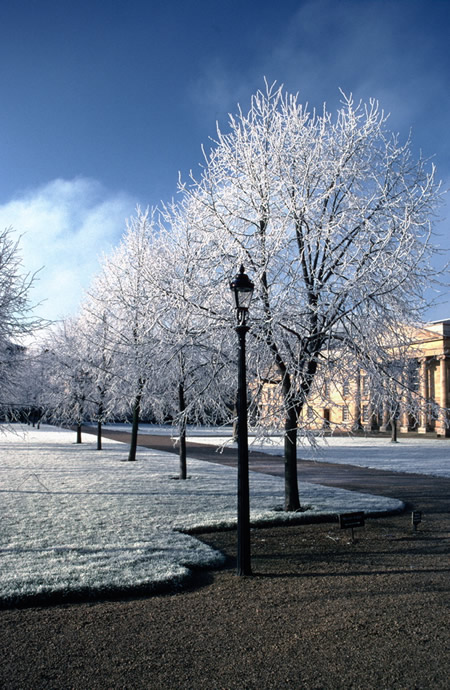
Photo: A frosty day. Downing College, University of Cambridge. Image Credit: Steve Day.
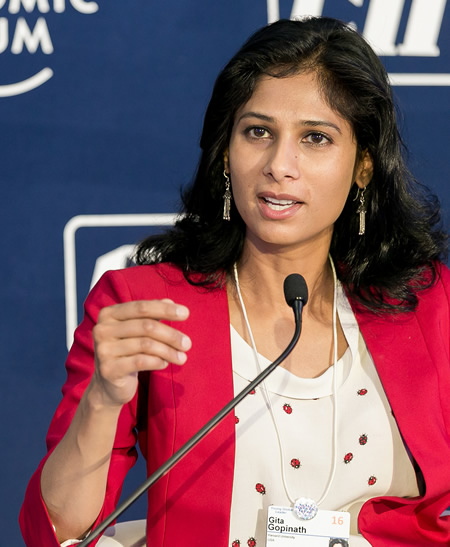
Photo: Gita Gopinath, Professor of Economics, Harvard University, USA, at the India Economic Summit 2016, New Delhi, India. Image provided by & copyright © World Economic Forum / Benedikt von Loebell.
LONDON — QS Quacquarelli Symonds, global higher education analysts, have released the eighth edition of the QS World University Rankings by Subject. The research project enumerates the world’s leading institutions for the study of 48 different subjects and five subject groups. The portfolio - the most extensive of its kind - is designed to provide a crucial comparative guide to university performance for students both aspiring and current, parents, career & study advisors, and academia.
This year, Harvard University retains its global pre-eminence. It ranks number-one for fourteen different subjects, outranking Massachusetts Institute of Technology (12 number-one ranks) and the University of Oxford (four number-one ranks).
Key Findings:
QS World University Rankings by Subject 2018
Institutions achieving most Top-10 Ranks
Institution — Country — Number of Subjects in which placed in Top-10
Ben Sowter, Research Director, QS, said: “For perhaps the first year since we began this research project, we see the improvement of Asian nations decelerate somewhat. There is no noteworthy proportional increase in the number of top-50 positions they take, and only the National University of Singapore demonstrates comprehensive competitiveness in the very highest echelons. The results demonstrate the difficulties facing any institution or system aiming to reach world-class research performance standards.”
ACADEMIC REPUTATION
QS RANK — UNIVERSITY — ACADEMIC REPUTATION SCORE
UNIVERSITIES FROM INDIA
QS RANK — UNIVERSITY — ACADEMIC REPUTATION SCORE
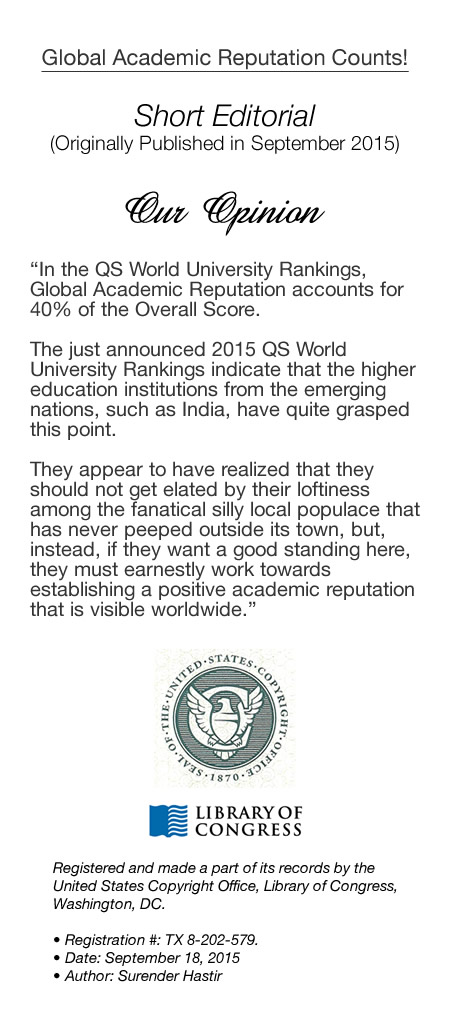
|GlobalGiants.Com|
Edited & Posted by the Editor | 6:10 AM | View the original post
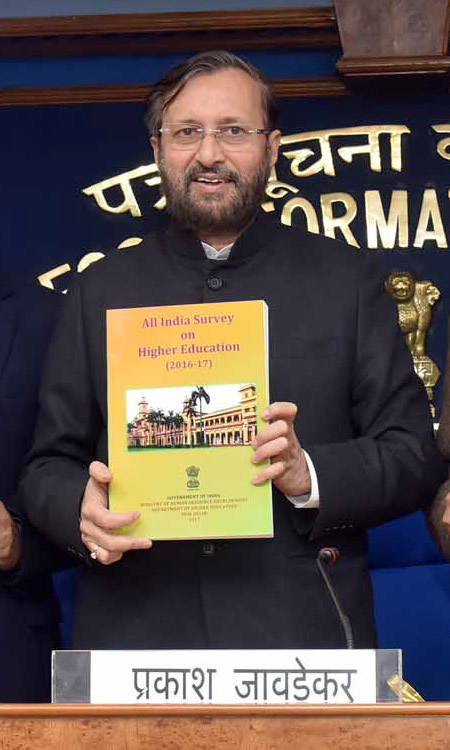
Photo: India’s Union Minister for Human Resource Development, Prakash Javadekar, releasing the final report of All India Survey on Higher Education (AISHE) for the year 2016-17, in New Delhi on January 05, 2018. Image provided by the Press Information Bureau, Government of India.
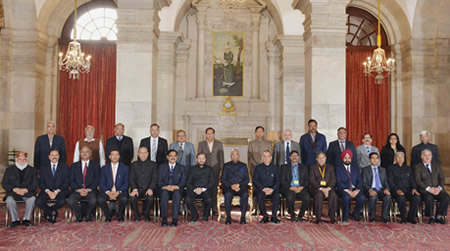
Photo: The President of India, Ram Nath Kovind, with the Vice Chancellors of 17 New Central Universities set up under the Central Universities Act, 2009, at Rashtrapati Bhavan, in New Delhi, on January 06, 2018. The Union Minister for Human Resource Development, Prakash Javadekar, is also seen. Image provided by the Press Information Bureau, Government of India.
India’s Union Minister of Human Resource Development, Prakash Javadekar, released the 8th All India Survey on Higher Education (AISHE) for the year 2016-17 in New Delhi today. On this occasion, he also launched the Survey for the year 2017-18.
Speaking on the occasion, Javadekar informed that there is an increase in overall enrolment.
He further informed that Gender Parity Index (GPI), a ratio of proportional representation of female and male, has improved from 0.86 to 0.94 to the corresponding period. To give a further boost to girl-students, the Minister announced that a supernumerary quota in IITs will be increased.
Javadekar informed that the number of institutions of higher education listed on AISHE portal has also increased significantly - from 621 universities in 2010-11 to 864 in 2016-17 and from 32,974 colleges in 2010-11 to 40,026 colleges in 2016-17.
He said that the government’s vision for the higher education is based on three important aspects, namely Quality, Autonomy, Research & Innovation.
The survey covers almost all the Higher Education institutions (HEIs) in the country including Universities, Colleges and Stand-Alone institutions. Identified nodal officers from each institution are primarily responsible for collecting and uploading the data on AISHE portal in a secured environment. It needs a lot of efforts in a survey of this scale to bring out the correct and complete picture of the system so that relevant statistics are available to the Central Government as well as State Governments, in order to devise future policies.
The survey is also unique in the sense that it is a participatory effort between State Governments, Regulatory Statutory Authorities and the Ministries of the Government of India. The Survey compiles and manages statistics directly online from respondent institutions. The main items of data collection under survey are Basic details, Programme details, Teaching & Non-Teaching Staff, Student Enrolment, Examination Result, Infrastructure, Scholarships, and Foreign students. The AISHE data is the main source of information for “Know Your College” portal.
|GlobalGiants.Com|
All India Survey of Higher Education Report has detailed information on 864 universities and 40,026 colleges The portal based survey method has reduced the time-lag in bringing out the report to a bare minimum. #AISHE #SabkoSikshaAcchiSiksha pic.twitter.com/6oZld4ScV9
— Ministry of HRD (@HRDMinistry) January 5, 2018
Edited & Posted by the Editor | 1:33 PM | View the original post
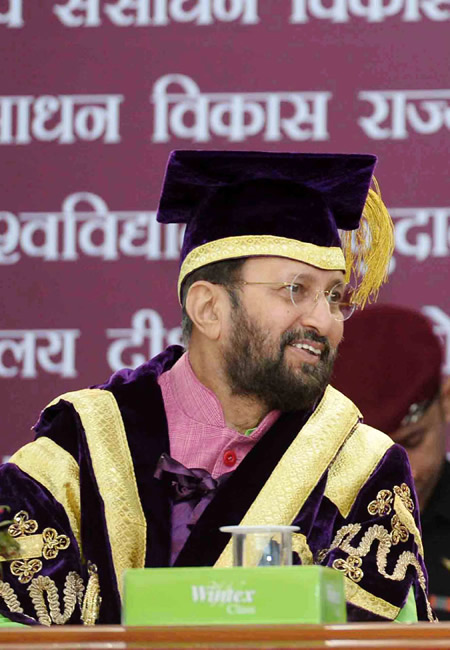
Photo: The Union Minister for Human Resource Development, Prakash Javadekar, at the 94th Annual Convocation of the University of Delhi, in New Delhi on November 18, 2017. Image provided by the Press Information Bureau, Government of India.
New Delhi — India Government had approved the enabling regulatory architecture for setting up or upgrading of 10 public and 10 private Institutions of Eminence so as to enable them to reach amongst top 100 of world institutions ranking. Accordingly, applications were invited, for which the last date was 12.12.2017. Overall 100 applications have been received.
Under Public Sector, 10 Central Universities, 25 State Universities, 6 Deemed to be Universities, 20 Institutions of National Importance and 6 Standalone Institutions have applied. Under Private Sector, 9 Private Universities and 16 Deemed to be Universities have applied in brownfield category and 8 Institutions have applied in greenfield category.
“Overwhelming response to the idea of Institutions of Eminence, which will become World Class Universities, is a validation of the vision of Prime Minister Narendra Modi for improving the quality of Higher Education in India”, Union Human Resource Development Minister Prakash Javadekar said.
“All lovers of education will welcome this development. This is how World Class Universities were built in various countries. The same thing will happen in India”, Javadekar said, adding that “the selection of Institutions of Eminence will not only improve the quality of education, but also propel competition in the entire education sector”.
The selection shall be made through challenge method mode by the Empowered Expert Committee constituted for the purpose. The selected 20 institutions shall be named as “Institutions of Eminence” which will have freedom to choose their own path to become world class institutions. These institutions shall be provided with greater autonomy viz. to admit foreign students up to 30% of admitted students; to recruit foreign faculty upto 25% of faculty strength; to offer online courses upto 20% of its programmes; to enter into academic collaboration with top 500 in the world ranking Institutions without permission of UGC; free to fix and charge fees from foreign students without restriction; flexibility of course structure in terms of number of credit hours and years to take a degree; and complete flexibility in fixing of curriculum and syllabus.
The scheme will enable Indian students to get world class education and research facilities within the country.
Among those who have applied from the public sector are seven Indian Institutes of Technology (Madras, Delhi, Bombay, Kharagpur, Kanpur, Guwahati, Roorkee), Delhi University and Jawaharlal Nehru University, Jadhavpur University, Goa University and Mangalore University.
From the private sector, the O P Jindal Global University, Ashoka University, Manipal University and Amity University, among others, have applied for the tag.
A screening committee will go through the applications and select the institutions.
|GlobalGiants.Com|
UGC receives 100 applications for HRD's world-class tag #InstitutesofEminence pic.twitter.com/9cPbgVYsKI
— Ministry of HRD (@HRDMinistry) December 13, 2017
विशà¥à¤µ सà¥à¤¤à¤°à¥€à¤¯ संसà¥à¤¥à¤¾à¤¨ का दरà¥à¤œà¤¾ पाने को आवेदन की होड़ #InstitutesofEminence pic.twitter.com/WN25QoeylX
— Ministry of HRD (@HRDMinistry) December 13, 2017
Edited & Posted by the Editor | 2:49 AM | View the original post
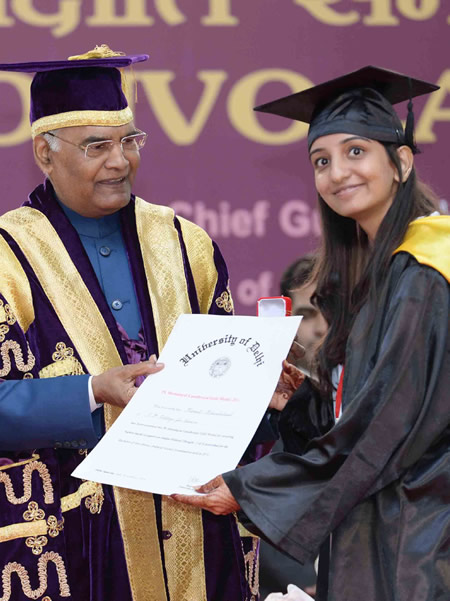
Photo: President of India, Ram Nath Kovind, presenting the degree certificate to a student at the 94th Annual Convocation of the University of Delhi, in New Delhi on November 18, 2017. (Image Credit: Press Information Bureau, Government of India.)
Speaking on the occasion, the President said that the University of Delhi is in many ways the University of India. Every state and region of our country is represented here. Each year thousands of eager young boys and girls travel to Delhi and apply to the University of Delhi or its affiliated colleges.
“Graduating from the University of Delhi has given you a firm foundation.” “It has empowered you to achieve more and aim higher as you walk into the world outside,” the President told the new graduates.
Every state and region of our country is represented in the University of Delhi. Young students from the Northeast add to the richness and vibrancy of the University campus and of the city of Delhi #PresidentKovind
— President of India (@rashtrapatibhvn) November 18, 2017
Under National Institutional Ranking Framework six colleges of the University of Delhi are ranked in the first 10 in our country. This is a commendable performance #PresidentKovind
— President of India (@rashtrapatibhvn) November 18, 2017
Hon'ble President Shri Ram Nath Kovind @rashtrapatibhvn inaugurated 94th Annual Convocation of #UniversityOfDelhi with HRD Minister @PrakashJavdekar by lighting lamp pic.twitter.com/U86KLb1J9f
— Ministry of HRD (@HRDMinistry) November 18, 2017
London, November 23, 2017 — Over 300 universities from India, China, Russia, South Africa and Brazil have been observed and graded for the Quacquarelli Symonds (QS) ranking, one of the global prestigious rankings.
China occupies seven of the top 10 positions in BRICS, while its Tsinghua University, Peking University, and Fudan University get the top three ranks with the country.
Unsurprisingly, China is the most represented country in this year’s ranking, followed by Russia. By contrast, only 12 South Africa universities are included, the highest-ranked of these being the University of Cape Town in 19th place - a fall of five places since last year.
As with the top 10, there is little movement in the top 50, with only four universities breaking in since last time. Those institutions are: National Research University - Higher School of Economics, Tomsk Polytechnic University (both based in Russia), Pontificia Universidade Católica de São Paulo and Universidade Federal de Minas Gerais (both Brazil).
From India, the Indian Institute of Technology Bombay has secured ninth rank followed by IISc, Bangalore (10), IIT Delhi (15) and IIT Madras (18).
Among India’s traditional universities, University of Delhi is at the top position within the country, followed by University of Calcutta.
• In India, the QS University Ranking BRICS 2018 edition was unveiled today at an event in New Delhi by Professor (Dr.) V.S. Chauhan, Chairman, University Grants Commission (UGC).
“Role of ranking in terms of students getting to know about the institutions can’t be negated, but also sometimes overplayed. Rankings are relevant for institutions and most importantly because of the rankings what happened in India is that institutions have started to look at themselves,” said Dr. Chauhan.
“Indian education has expanded and we are trying to change a lot of regulations which are made long ago. In this there is space for rankings and the government is also realising this that the universities are a matter of prestige for the country,” he added.
Chauhan, while noting that the country is at a very early stage of its universities coming of age, said, “We will celebrate that day when of 350 universities 150 of them will be Indian institutions in the BRICS rankings.”
Based on eight performance indicators, namely academic reputation, employer reputation, proportion of staff with a PhD, faculty/student ratio, research publications, citation rates, proportion of international faculty, and proportion of international students, the ranking provides insights into the relative strengths and weaknesses of leading institutions in the five countries.
QS BRICS UNIVERSITY RANKINGS 2018 — TOP 20
RANK — INSTITUTION — COUNTRY
INSTITUTIONS FROM INDIA
QS BRICS RANK — INSTITUTION
|GlobalGiants.Com|
🇧🇷 🇷🇺 🇮🇳 🇨🇳 🇿🇦
— GlobalGiants.Com (@GlobalGiants) November 23, 2017
Thanks @TopUnis. Check our post here: https://t.co/7Djk5ftHiK
3 #IITs, #IIS, Bangalore make the cut among top 20 varsities in #BRICS countries: Latest QS Rankings
— Press Trust of India (@PTI_News) November 22, 2017
It is no mean achievement to see 65 Indian universities being ranked in 2018 @worlduniranking for BRICS, which is more than Brazil (61) & South Africa (12) #QSWUR @narendramodi @PMOIndia (3/5)
— Prakash Javadekar (@PrakashJavdekar) November 23, 2017
Edited & Posted by the Editor | 6:44 AM | View the original post
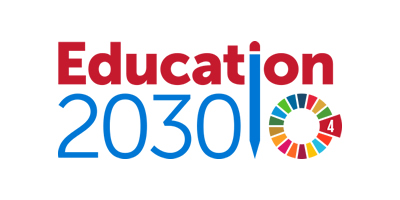
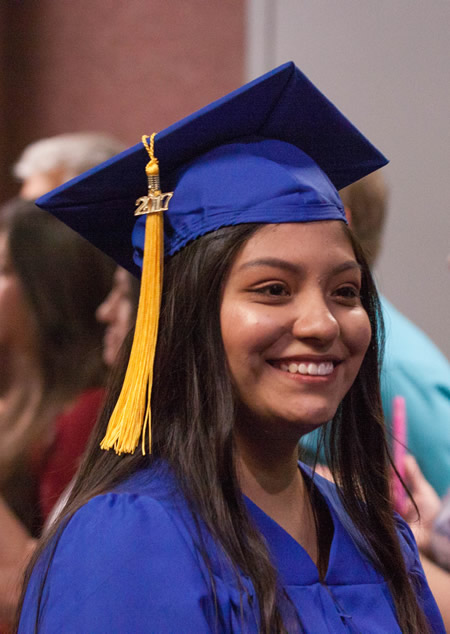
Photo: University student attending commencement (convocation). Image Credit: Southwestern Adventist University.
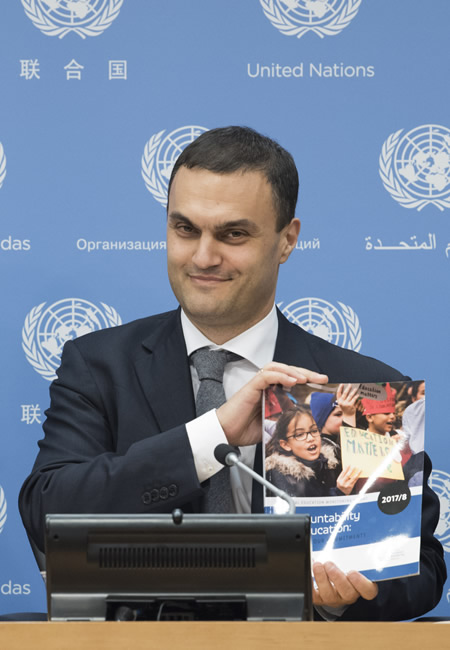
Photo: Manos Antoninis, Director of the Global Education Monitoring Report of the United Nations Educational Scientific and Cultural Organization (UNESCO), briefs journalists on the global launch of UNESCO’s flagship annual education report. 26 October 2017. United Nations, New York. UN Photo/Kim Haughton.
Paris, France, 14 November 2017 — UNESCO Member States today approved continuation of the preparation of UNESCO’s Global Convention on the Recognition of Higher Education Qualifications.
• The Convention would provide a global framework of universal principles and rules for the recognition of higher education titles, degrees, diplomas, and certificates.
The General Conference reaffirmed that the global convention will enhance international cooperation in higher education and will be a significant step forward towards global academic mobility and trust in higher education systems.
The Convention will be a major step forward for the rights of students to have their higher education qualifications assessed in a fair, transparent, and non-discriminatory manner by national competent authorities. It will also strengthen cooperation in higher education among member states and enhance trust in higher education systems by ensuring quality in education in line with the Sustainable Development Goals.
Since its creation, UNESCO has served as a global platform for discussion on the recognition of higher education qualifications and the promotion of academic mobility.
Global academic mobility is sharply on the increase with the overall population of mobile students doubling since 2002. Today more than 4 million students study outside their home country and it is estimated that by 2020 around 8 million students will be studying abroad.
This significant growth in mobile tertiary students calls for a global regulatory framework for the recognition of higher education qualifications. This framework will reduce the obstacles faced by students, teachers, researchers and job-seekers within and outside their countries of origin.
|GlobalGiants.Com|
Edited & Posted by the Editor | 1:12 AM | View the original post

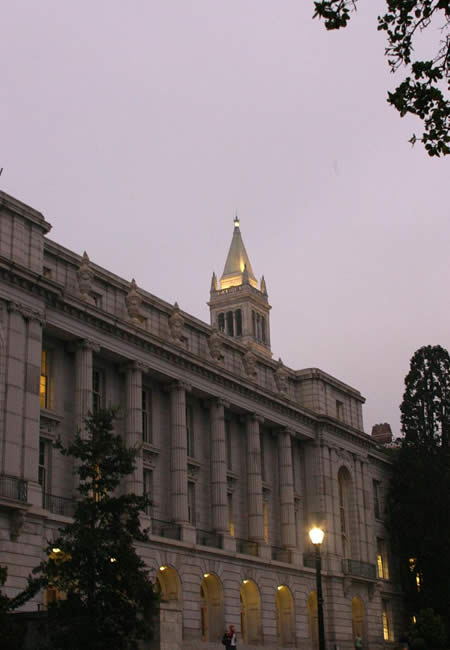
Photo: University of California, Berkeley. A section of the campus during night. Image Credit: J. Hendron.
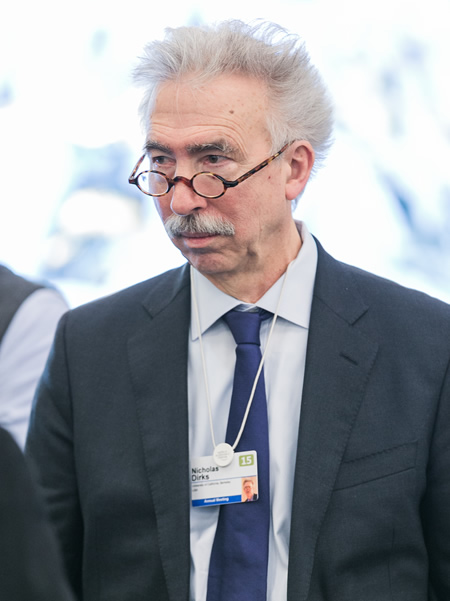
Photo: Nicholas Dirks, Chancellor, University of California, Berkeley, USA, captured during the session Human vs Artificial Intelligence in the Congress Centre at the Annual Meeting 2015 of the World Economic Forum in Davos, Switzerland. Image provided by & copyright © World Economic Forum / Benedikt von Loebell.
WASHINGTON, Oct. 24, 2017 — U.S. News & World Report, a global authority in education rankings for more than 30 years, today released the 2018 Best Global Universities rankings. The overall rankings evaluate 1,250 universities - up from 1,000 last year - across 74 countries and are the largest and most comprehensive assessment of research universities worldwide.
The U. S. leads the rankings again this year, with 221 universities making the overall list. The top four spots are held by U.S. schools, with Harvard University at No. 1. The Massachusetts Institute of Technology comes in at No. 2, followed by Stanford University at No. 3 and the University of California—Berkeley at No. 4. The United Kingdom’s University of Oxford rounds out the top 5.
Behind the U.S., the following countries have the most ranked institutions out of the 1,250 schools on the overall list:
China: 136, Japan: 76, U.K.: 73, Germany: 58
Across the 22 subject-specific rankings, U.S. schools again claim the most No. 1 spots. For the first time, China’s Tsinghua University replaces MIT as No. 1 in computer science and once again tops the list for engineering. Listed in rank order, these countries performed the best in the following subject rankings:
“The schools that rank the highest in the Best Global Universities rankings are those that emphasize academic research, including by partnering with international scholars to produce highly cited articles,” said Robert Morse, chief data strategist at U.S. News. “This is different from the Best Colleges rankings, which measure the overall quality of undergraduate institutions in the U.S. and focus on student outcomes such as graduation and retention rates.”
For the 2018 edition, U.S. News made a slight change to the methodology to further emphasize international collaboration at universities by rewarding schools that author articles with researchers from different countries.
The Best Global Universities methodology - which is based on Web of Science data and metrics provided by Clarivate Analytics InCites - weighs factors that measure a university’s global and regional research reputation and academic research performance. For the overall rankings, this includes bibliometric indicators such as publications, citations and international collaboration. Each subject ranking has its own methodology based on academic research performance and reputation in that specific area.
“For more than 30 years, U.S. News has been committed to making higher education data more accessible to prospective students choosing a U.S. university,” said Anita Narayan, managing editor of Education at U.S. News. “The Best Global Universities rankings similarly allow consumers to accurately evaluate and compare international schools to find the right fit for them, based on available data.”
2018 U.S. News & World Report Best Global Universities
Overall Best Global Universities - Top 10
Africa - Top 5
Asia - Top 5
Australia/New Zealand - Top 5
Europe - Top 5
Latin America - Top 5
The Best Global Universities rankings serve the broader U.S. News mission to provide trusted information and rankings to help all students navigate their higher education options - including with the Best Colleges, Best Graduate Schools and Best Online Programs rankings. For Chinese students in particular, U.S. News offers online resource centers published in Chinese to help guide prospective undergraduate and graduate students interested in studying abroad. In addition, U.S. News is continuing to collaborate with U.S. News Global Education, a subsidiary company of Shorelight Education, to help international students and their families connect with universities.
|GlobalGiants.Com|
Edited & Posted by the Editor | 1:19 PM | View the original post
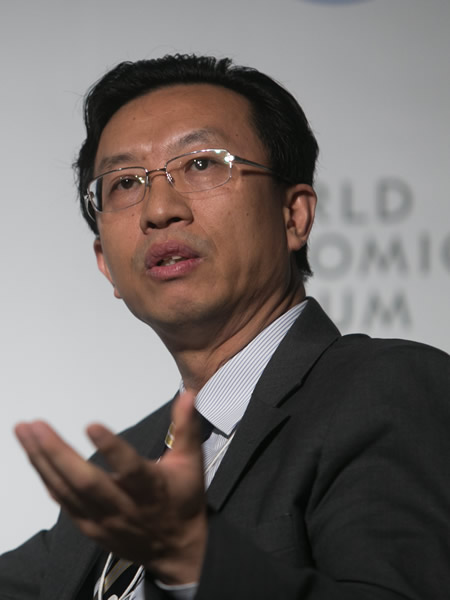
Photo: Hongbo Chen, Vice-Dean, Tuspark Research Institute for Inovation, Tsinghua University, Beijing, China, during “Incubating Entrepreneurship” discussion at the World Economic Forum Meeting in Dalian, People’s Republic of China. Image provided by & copyright © World Economic Forum / Ciaran McCrickard.
The results of the QS Asia University Rankings are out now featuring 450 of the top universities in Asia. The ranking is based on a methodology which considers 10 performance indicators, including academic and employer reputation, the proportion of PhD qualified academic staff, and the proportion of inbound and outbound exchange students at the university.
QS ASIA UNIVERSITY RANKINGS 2018 — TOP 30
QS RANK — INSTITUTION — COUNTRY
Indian Institute of Technology (IIT) Bombay emerged as the best Indian university. It was ranked 34th in Asia, followed by IIT Delhi (41), IIT Madras (48,) and Indian Institute of Science, Bengaluru (IISc) at 51. The 2018 rankings by QS showed that IISc, which was the best institution from India in 2016 and 2017, slipped the most among top Indian schools.
Traditional universities from India were led by University of Delhi (72), followed by Jadavpur University (125), University of Calcutta (125), Amrita University (168), University of Mumbai (181), Jamia Millia Islamia, New Delhi (200), Savitribai Phule Pune University (207), and Thapar University, Patiala (210).
QS ASIA UNIVERSITY RANKINGS 2018 — INDIA
QS RANK —Â INSTITUTION
National University of Sciences And Technology, Islamabad (91) emerged as Pakistan’s highest ranked institution in QS Asia 2018 rankings. It was followed by Lahore University of Management Sciences (103), Pakistan Institute of Engineering and Applied Sciences (128), Quaid-i-Azam University (133), COMSATS Institute of Information Technology (190), University of Karachi (193), University of Engineering & Technology Lahore (200), University of the Punjab (PU), Lahore (232), and Aga Khan University (234).
QS ASIA UNIVERSITY RANKINGS 2018 — PAKISTAN
QS RANK —Â INSTITUTION
Methodology
QS uses a unique methodology to calculate this ranking. The methodology is designed to account for the unique challenges facing the region’s universities, and features 10 indicators. They are:
Ben Sowter, Research Director, QS, said: “This year’s rankings suggest that, in a number of nations, established hierarchies are being disrupted. This is a result of the region’s many universities continually striving to become competitive, forward-thinking, and internationally attractive.”
|GlobalGiants.Com|
Edited & Posted by the Editor | 4:40 AM | View the original post
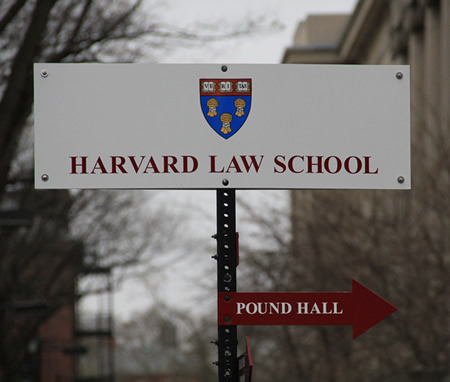
Photo: A Harvard Law School Signboard. Image Credit: Ryan Ward.
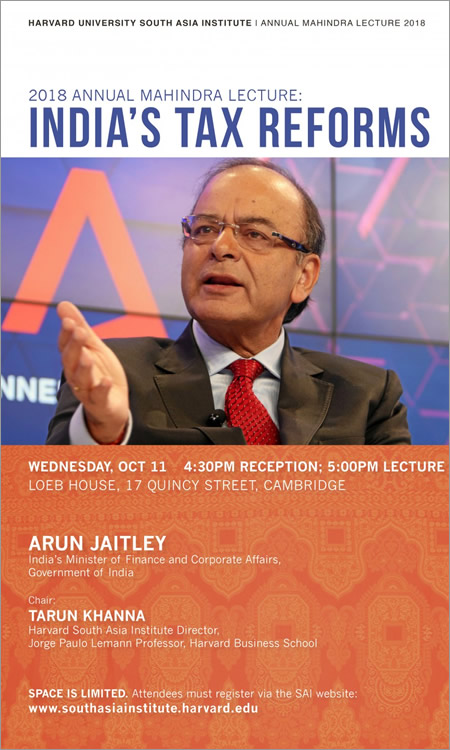
Photo: Event Announcement, Arun Jaitley’s lecture at the South Asia Institute, Harvard University.
WASHINGTON: India’s Finance Minister, Arun Jaitley will address students of the prestigious Harvard University on October 12.
At Harvard, on October 12, the Finance Minister would deliver the ‘Mahindra Lecture’ in honour of late Harish C Mahindra, a distinguished alumnus of Harvard College and a visionary leader of business and industry in India, the South Asia Institute of Harvard University said in an announcement.
On the First Leg of his US visit, Jaitley will arrive in New York on the morning on 9th October, 2017. His major engagements during his one day stay at New York include Meeting with the Investors in partnership with Bank of America and Confederation of Indian Industries (CII). Thereafter, he will participate in the Roundtable Meeting of CEOs of USIBC-CII.
Next day, i.e., Tuesday, 10th October, 2017, he will deliver a Lecture on “FDI: Achievements and Challenges” at Columbia University. In the evening, he will leave for Boston.
On Wednesday, 11th October, 2017, Mr. Jaitley will participate in the Roundtable Investment Meet being organised in Boston in collaboration with NIIF, USISPF and FICCI on the subject of “Indian Economy - The Road Ahead”.
Later in the evening, he will deliver a Lecture on India’s Tax Reforms at the South Asia Institute, Harvard University.
On the morning of Thursday, the 12th October, 2017, the Finance Minister will leave for Washington D.C. to participate in the Annual Meetings of the World Bank and International Monetary Fund (IMF).
According to political analyst, Nikhila Natarajan, Jaitley would be visiting two “Ivy League” colleges - Columbia and Harvard.
“Yale, Harvard, University of Pennsylvania, Brown, Dartmouth, Cornell, Columbia and Princeton,” she explains, “form the league of eight, called ‘Ivy League’, which embraces a wide sweep of connotations, including but not limited to academic excellence, selectivity in admissions, social elitism, and a common high-water mark for scholarship and athletics.”
|GlobalGiants.Com|
Edited & Posted by the Editor | 3:49 PM | View the original post
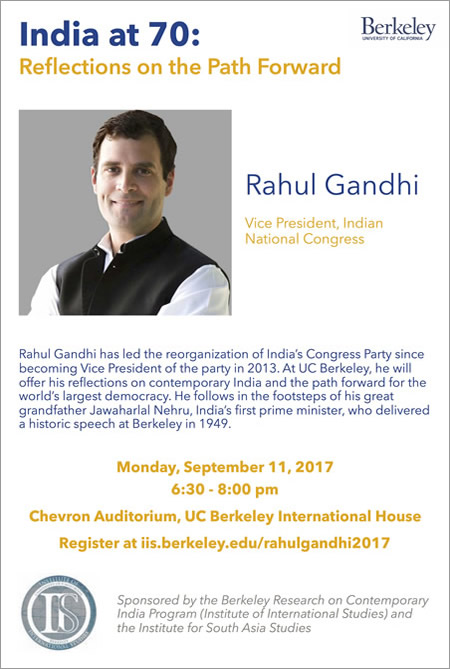
Photo: Rahul Gandhi talk. Event Flyer.

Photo: A walkout on the UC Berkeley campus. Year 2009. Image Credit: Ben Chaney.
Berkeley, California: Indian National Congress vice president Rahul Gandhi today began his two-week visit to the US during which he will interact with global thinkers and political leaders as part of an outreach initiative by his party.
In his first engagement, Gandhi would address students of the prestigious University of California, Berkeley, on ‘India at 70: Reflections on the Path Forward’, in which he would talk about his vision about India and where the country is leading.
“He is here at the University of California, Berkeley, where Pandit Jawaharlal Nehru addressed in 1949 as the Prime Minister. Today we are at the cross roads where core value of Indian democracy, secularism, and pluralistic society is in danger,” Congress spokesman Madhu Goud Yaskhi said.
The event venue is full and the registration for Rahul Gandhi’s talk has already been closed. The event will be held at the Chevron Auditorium, UC Berkeley International House, from 6.30 PM to 8 PM local time.
The event is being sponsored by the Institute for South Asia Studies, UC Berkeley; and the Berkeley Research on Contemporary India Program, Institute of International Studies, UC Berkeley.
|GlobalGiants.Com|
Edited & Posted by the Editor | 5:41 PM | View the original post
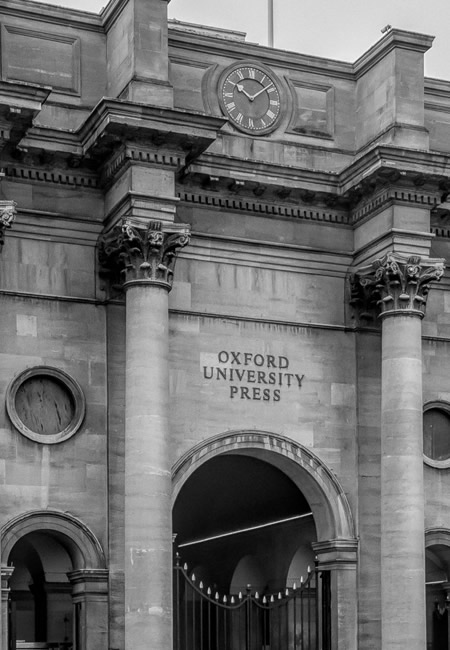
Photo: Oxford University Press, the largest university press in the world, founded 1586. Image Credit: David Nicholls.
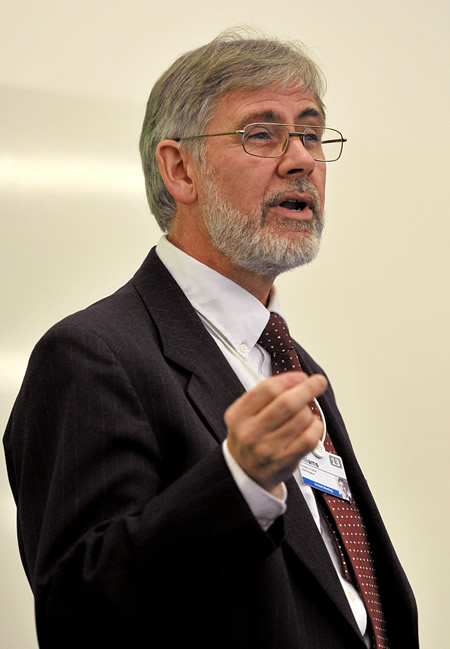
Photo: Mark Williams, Professor of Clinical Psychology, University of Oxford, United Kingdom, gestures during the WorkStudio ‘Experiencing Mindful Leadership’ at the Annual Meeting 2013 of the World Economic Forum in Davos, Switzerland, January 23, 2013. Image provided by & copyright © World Economic Forum. Photographer: Urs Jaudas.
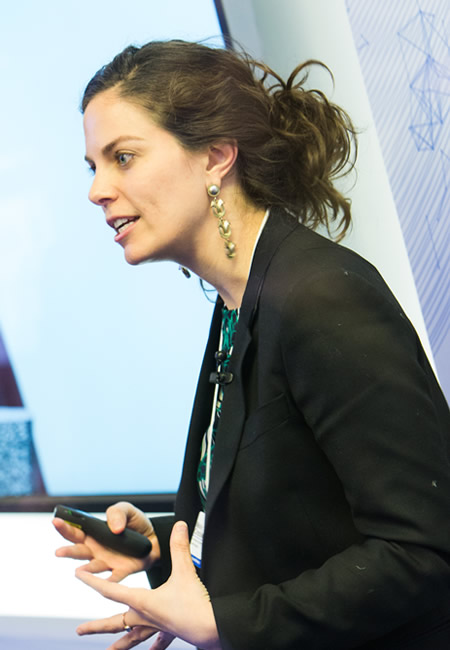
Photo: Molly Crockett, Associate Professor of Experimental Psychology, University of Oxford, United Kingdom at the Annual Meeting 2017 of the World Economic Forum in Davos. Image provided by & copyright © World Economic Forum. Photographer: Sikarin Thanachaiary.
The 2018 World University Rankings launched today at the ongoing THE World Academic Summit in London feature 1,000 institutions for the first time. The rankings feature institutions from 77 different countries.
• The University of Oxford has held on to the number one spot for the second year in a row, while the University of Cambridge has jumped from fourth to second place.
Cambridge’s rise comes at the expense of the California Institute of Technology, which was number one between 2012 and 2016, number two last year, and now shares third position with Stanford.
Louise Richardson, Oxford’s vice-chancellor, said that she was “delighted that Oxford has held its position at the top of these global rankings”.
“To be judged the best university in the world for the second successive year, against a backdrop in which Britain’s role in the world is uncertain and the place of universities in society open to question, will be a great source of pride for everyone at Oxford,” said Professor Richardson.
“Success in our field is never an accident,” she added, stating that it is “achieved by a relentless pursuit of excellence, creative brilliance and a deep commitment to our enduring values”.
Sir Leszek Borysiewicz, Cambridge’s vice-chancellor, said that the result confirms that the university “is among a small group of the most respected higher education institutions globally”.
Peking University has risen two places to joint 27th, which puts it on a par with New York University and the University of Edinburgh. While Tsinghua University has climbed five places to 30th, overtaking the University of Melbourne, Georgia Institute of Technology, LMU Munich and École Polytechnique Fédérale de Lausanne. Both those Chinese institutions have improved in terms of their reputations for teaching and research this year.
The Times Higher Education World University Rankings 2018: Top 30
Rank — Institution — Country
Indian institutes continued to perform poorly with the Indian Institute of Science (IISc) Bangalore sliding in the rankings. Though IISc remained the top university in India, it was placed in the 251-300 groupings of the best universities, a fall from the 201-250 cohort of the previous edition of the ranking.
“It is disappointing that India has declined in the THE World University Rankings amid increasing global competition. As leading universities in other Asian territories such as China, Hong Kong and Singapore are consistently rising up the rankings, in part thanks to high and sustained levels of funding, India’s flagship the Indian Institute of Science moves further away from the elite top 200,” said Phil Baty, editorial director of global rankings of THE.
Indian universities performed poorly on internationalization, which measures how successful a school is in attracting foreign students and staff, a traditional shortcoming of the Indian institutions. “Government policy strictly limits the number of students from abroad who can study in India and prevents international scholars from being hired into long-term faculty positions. The rankings may improve in the near future as Indian schools go about improving the internationalization aspect,” THE said.
INDIA — Top 20
THE Rank — Institution
According to Times Higher Education, “Tens of millions of students and their families, as well as academics and university leaders, view the results. The rankings not only inform students’ choice of university and academics’ career decisions, but they also shape institutional strategy and national government higher education policies in many countries.”
“We cannot develop the rankings and analyses we do without institutions signing up to our data collection system and investing the time and resources to share data in accordance with THE’s unique global data definitions. So we thank all institutions that engaged with the process this year for their commitment and support for our exciting global project. We are confident that the payback, through all the insights brought about by the rankings and the related analyses and benchmarking tools, is clear to all of our university partners,” THE said.
“Times Higher Education World University Rankings are the only global performance tables that judge research-intensive universities across all their core missions: teaching, research, knowledge transfer and international outlook. We use 13 carefully calibrated performance indicators to provide the most comprehensive and balanced comparisons, trusted by students, academics, university leaders, industry and governments. The performance indicators are grouped into five areas: Teaching (the learning environment); Research (volume, income and reputation); Citations (research influence); International outlook (staff, students and research); and Industry income (knowledge transfer),” THE explained.
|GlobalGiants.Com|
Edited & Posted by the Editor | 1:01 PM | View the original post
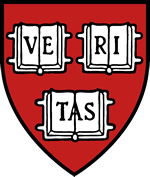
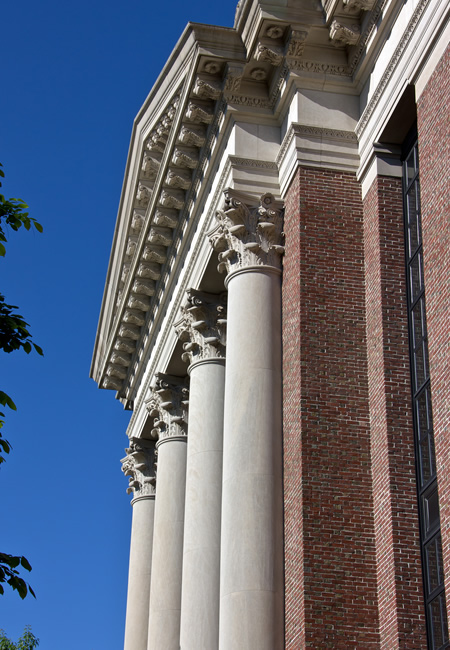
Photo: Section of a building at Harvard Yard, Harvard University, Cambridge, Massachusetts, USA. Image Credit: Andreas Metz.
Times Higher Education (THE) has just announced the results of its World Reputation Rankings 2017. These rankings are based on the world’s largest invitation-only academic opinion survey to provide the definitive list of the top 100 most powerful global university brands.
Harvard University tops this year’s list of the world’s most prestigious universities, and it does that for the seventh year in a row.
But, while North America continues to dominate the table, several of the region’s most reputable institutions have been outshone by leading Asian brands for the first time. China’s Tsinghua University and Peking University both leapfrogged the University of Pennsylvania and Cornell University in the table this year while the University of Tokyo now has a stronger reputation than Columbia University. Meanwhile, Seoul National University is now considered more prestigious than the University of California, Davis.
Leading universities in Belgium, Germany, France and the Netherlands have also lost ground as universities in Asia have become more prominent brands on the global stage.
Overall, 19 countries across Europe, Australasia, Asia, North America and Latin America are represented in the seventh annual edition of the table.
World’s Most Prestigious Universities 2017
Top 50
Rank - Institution - Location - Overall Score
51-60
61-70
71-80
81-90
91-100
Reputation ranking is not academic ranking. Rather, as Times Higher Education explains, it lists the world’s top 100 universities based purely on their prestige.
THE’s World Reputation Rankings are based on an annual invitation only Academic Reputation Survey. According to THE, this year, the survey received responses from more than 10,500 scholars across 137 countries. Each of these academics represented his country as well as his peers in his field of expertise. The survey had asked experienced, published academics to outline which universities they perceived to be the best for teaching and research in their specialist discipline.
As higher education becomes more international and more competitive, the universities that are succeeding are the institutions that have made their reputation central to their strategy. A good reputation attracts talent, investment and partnerships.
National governments accept that universities now form an essential component of their country’s soft power. For university leaders, donors, partners, faculty and students, the reputation of their institution is the foundation that strengthens and drives their decision making, and highlights the value they place on the university’s research and teaching.
The ESSENCE of our following opinion, expressed in 2015, still holds good.
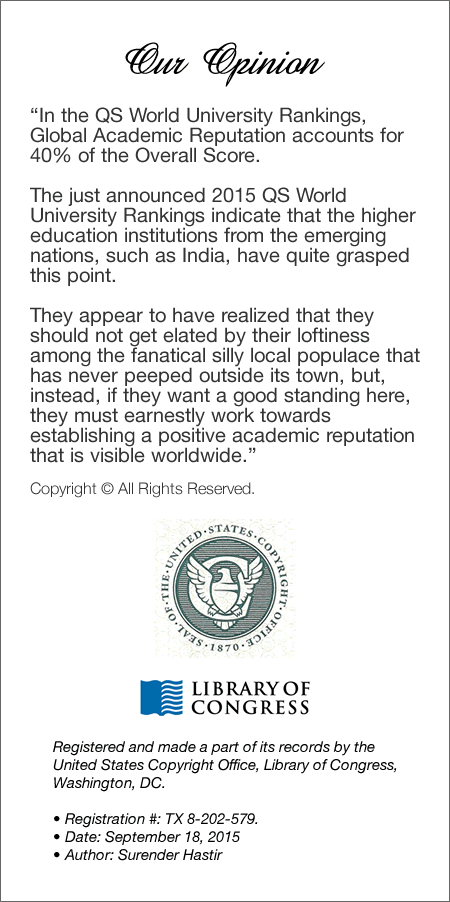
|GlobalGiants.Com|
Edited & Posted by the Editor | 1:30 PM | View the original post
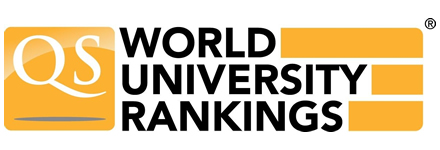
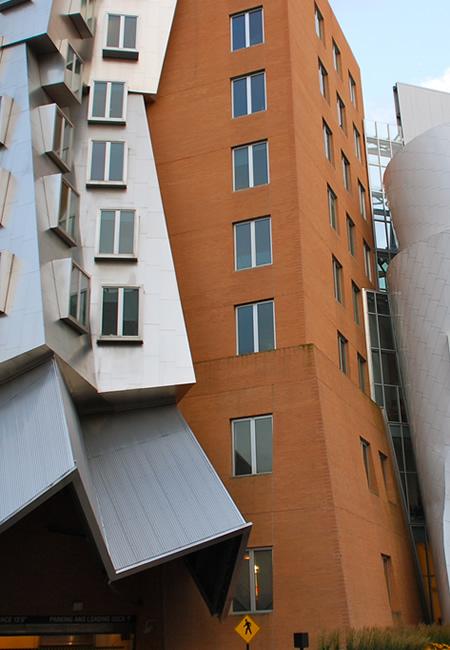
Photo: A section of the Stata Center building, Massachusetts Institute of Technology (MIT), Cambridge, MA, USA. Image Credit: Adam Fagen.
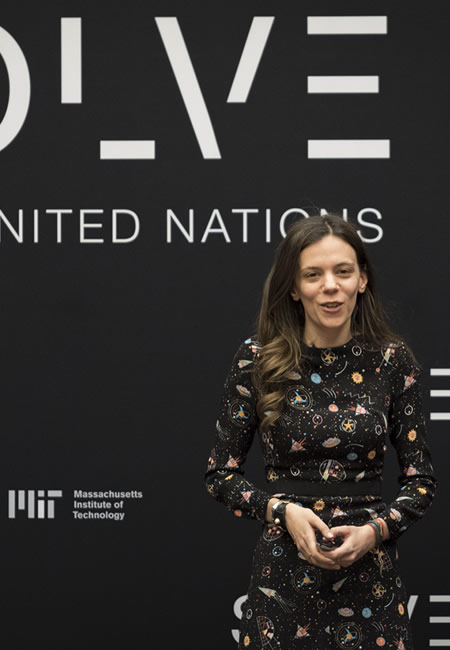
Photo: Alexandra Amouyel, Executive Director of Solve at Massachusetts Institute of Technology (MIT), during the recent “Solve at the United Nations” event. Solve is an MIT initiative “connecting innovators with resources to solve global challenges”. United Nations, New York. UN Photo/Mark Garten.
LONDON, June 7, 2017 — QS Quacquarelli Symonds, higher education experts, have released the 14th annual QS World University Rankings.
Massachusetts Institute of Technology (MIT) is the world’s leading university for a record sixth consecutive year. 959 universities are ranked.
Ben Sowter, Research Director, QS, said: “MIT is the nucleus of an unrivalled innovation ecosystem. Companies created by its alumni enjoyed combined revenues of $2 trillion, making them the equivalent of the world’s 11th largest economy.”
QS World University Rankings 2018: Top 20


PRESIDENT OF INDIA RECEIVES 2018 EDITION OF THE QS WORLD UNIVERSITY RANKINGS
New Delhi, Rashtrapati Bhavan:
The President of India, Shri Pranab Mukherjee received the 2018 edition of the QS World University Rankings brought out by the Education Promotion Society of India (EPSI) at a function held at Rashtrapati Bhavan.
Speaking on the occasion, the President said that he was happy to find three Indian institutions - IIT Delhi and IISc Bangalore, which were already in the top 200, and the latest entrant IIT Bombay securing ranks within the coveted top 200 and IISc Bangalore being now ranked 6th globally for Citations per Faculty.
The President said that while in terms of infrastructure there has been considerable expansion in the higher education sector, quality of education in many institutes remains a matter of concern. In ancient times, we had renowned seats of higher learning - Nalanda, Takshashila, Vikramashila, Valabhi, Somapura and Odantapuri - that dominated the world higher education system for eighteen hundred years beginning sixth century BC. Scholars from round the globe flocked to these centres of learning in search of knowledge. A reverse scenario exists today. Many meritorious Indian students pursue their higher studies from foreign universities. Our higher learning institutions are capable of producing world-class scholars but lose them to foreign universities.
The President said that during his visits to the universities in his capacity as Visitor to Central Intuitions of Higher Learning, he had been sharing his concerns about the performance of Indian institutions in world university rankings. A high rank can boost the morale of the academic and student communities, open greater avenues of growth and placement for students, help attract the best faculty from across the world, and provide a benchmark for continuous quality enhancement.
|GlobalGiants.Com|
Edited & Posted by the Editor | 3:36 AM | View the original post

Photo: A College Student. Image Credit & Photographer: Francisco Osorio.
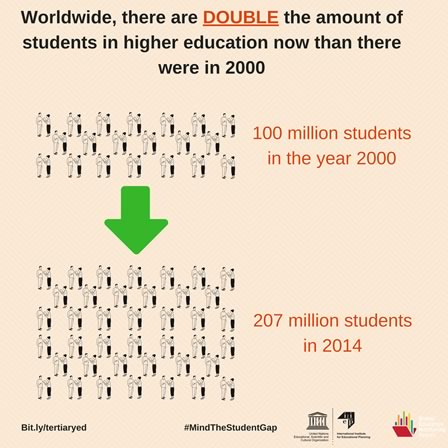
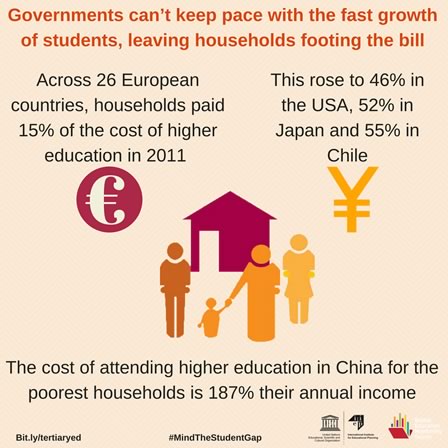
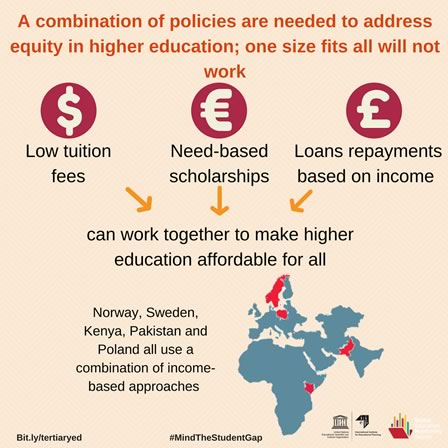
A new policy paper from the Global Education Monitoring (GEM) Report and the International Institute for Educational Planning (IIEP) at UNESCO shows that the number of university level students doubled to 207 million between 2000 and 2014. Governments are struggling to keep pace with rapidly rising demand and large disparities in access, with a large cost of higher education often falling to families, many of whom cannot afford it.
The new paper, Six ways to ensure higher education leaves no one behind, sets out a series of measures to make higher education more equitable and affordable, including to ensure that student loan repayments do not exceed 15% of a student’s monthly income. Anything more threatens to leave the disadvantaged behind.
“By creating and transmitting vital knowledge, skills and core values, higher education is a cornerstone for achieving the Sustainable Development Goals,” said Irina Bokova, Director-General of UNESCO. “Demand for higher education is going to continue rising. Governments must respond by introducing a range of new policies that will ensure expansion doesn’t leave the marginalised behind, and that access is based on merit, not privilege.”
Analyzing global trends, the paper also shows that only 1% of the poorest students have spent more than four years in higher education, compared to 20% of the richest.
In South Africa, around one-sixth of blacks and coloreds attended higher education in 2013, compared to over 50% of whites. Similarly, in Mexico, less than 1% of the indigenous population attend higher education. In China, youth from rural areas are seven times less likely to attend university than students from urban areas.
Access to higher education has expanded most rapidly in wealthier countries: Only 8% of young adults are enrolled on average in the poorest countries, compared to 74% in the richest countries. The greatest gender disparities are found among the poorest countries as well. Women made up only 30% of bachelor students in low-income countries in 2014.
“In certain countries with deeply rooted social inequities, affirmative action through quota or bonus systems may be necessary to expand access to underrepresented groups, even if these mechanisms are controversial,” says Suzanne Grant Lewis, director of the IIEP.
Private colleges and universities have expanded to cater to the growing pool of students, enrolling 30% of all students worldwide, rising to 50% in Latin America.
Governments can’t keep pace financially with this expansion and families are left with the tab. Across 26 countries in Europe, households paid for 15% of the cost of higher education in 2011. In other high-income countries, household expenditures were even higher: 40% in Australia, 46% in the USA, 52% in Japan, and 55% in Chile.
UNESCO, the only UN organization with responsibility for higher education, advises governments to use a combination of policies aimed at helping the disadvantaged, such as low tuition fees, need-based scholarships and loans repayments adjusted according to income, to help families manage the costs. The paper draws on a range of examples to show how different countries are expanding and diversifying higher education offerings to achieve greater equity.
“The last thing we want is for higher education to be the ball and chain around students’ ankles,” said Aaron Benavot, Director of the GEM Report. “Coping with dramatic student expansion is not easy, but there are policy solutions governments can put into place to stop the bill falling to households.”
Six specific recommendations are given to policy makers to make higher education equitable and affordable for all:
|GlobalGiants.Com|
Edited & Posted by the Editor | 3:32 PM | View the original post
 |
 |
